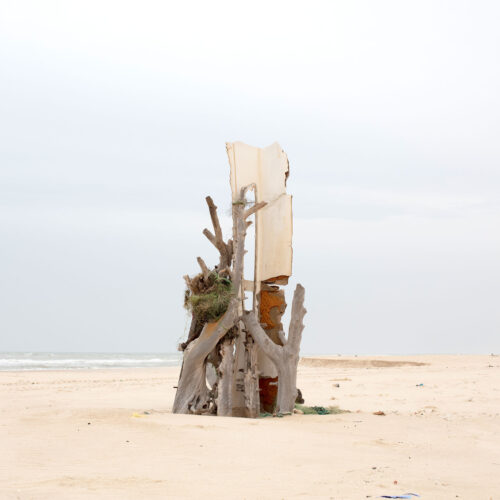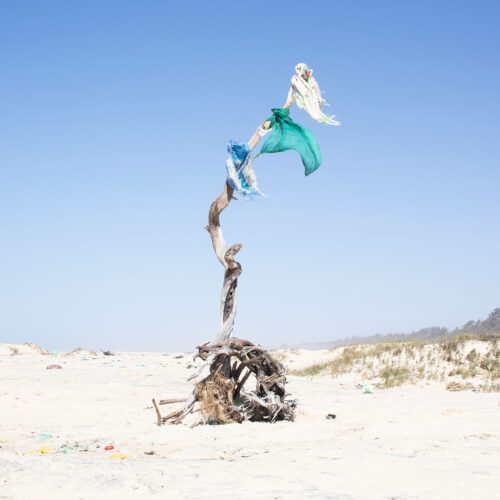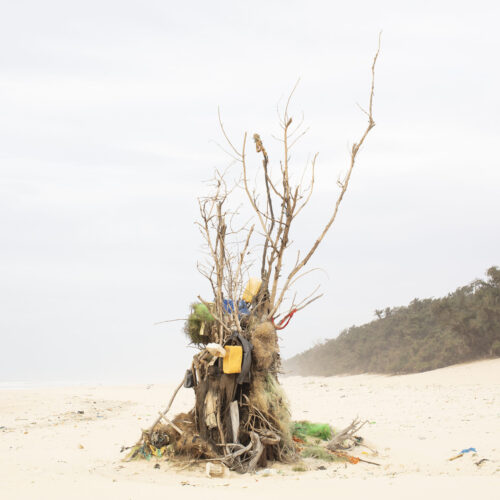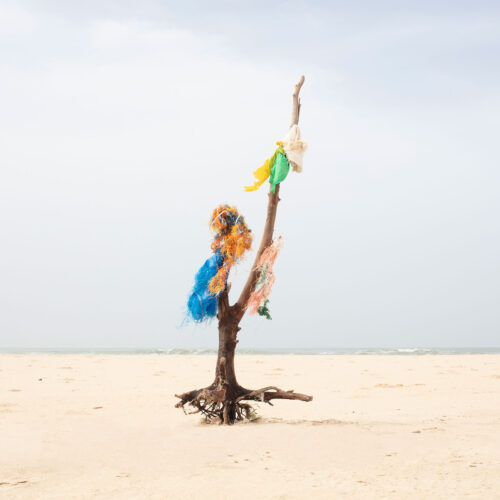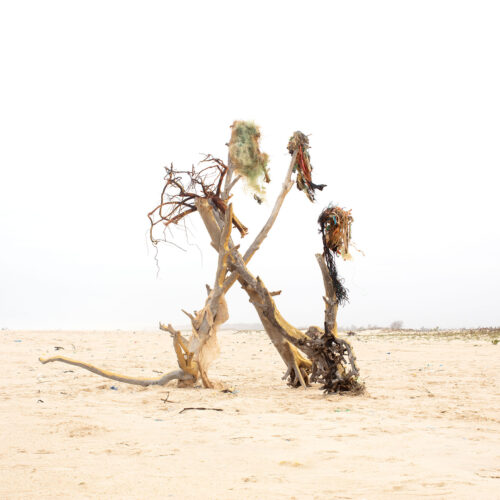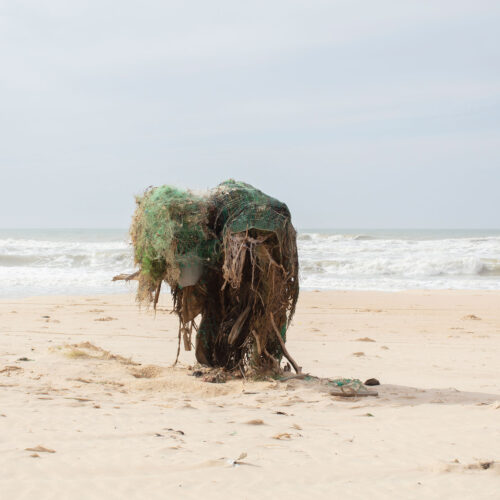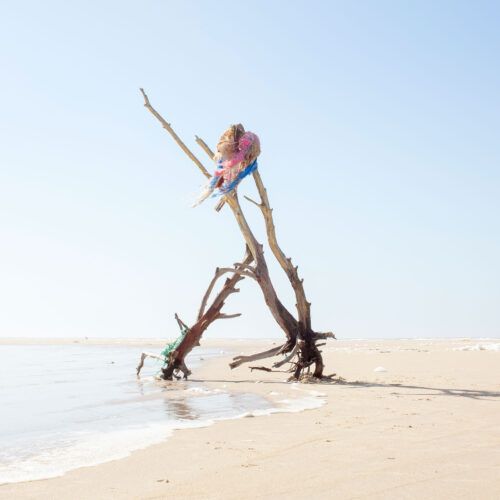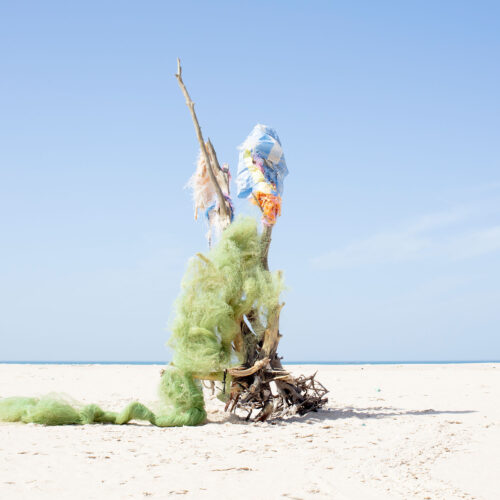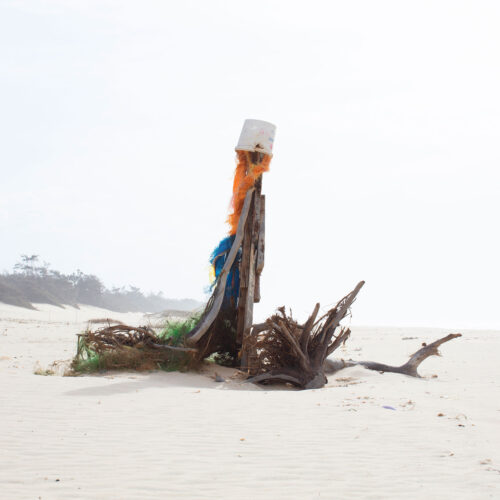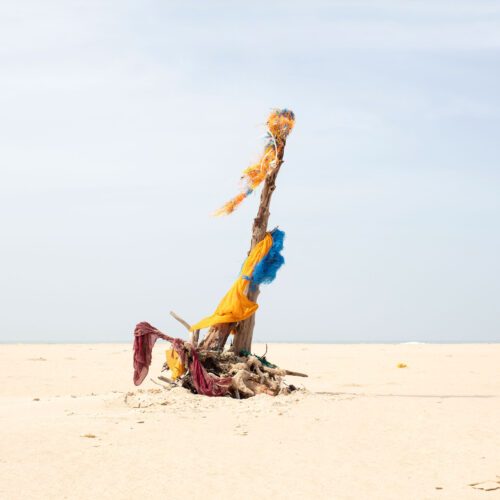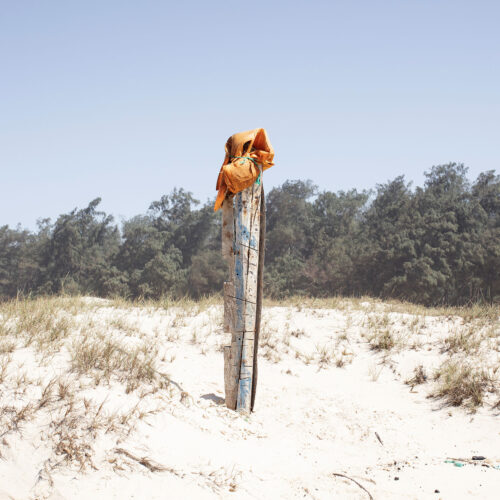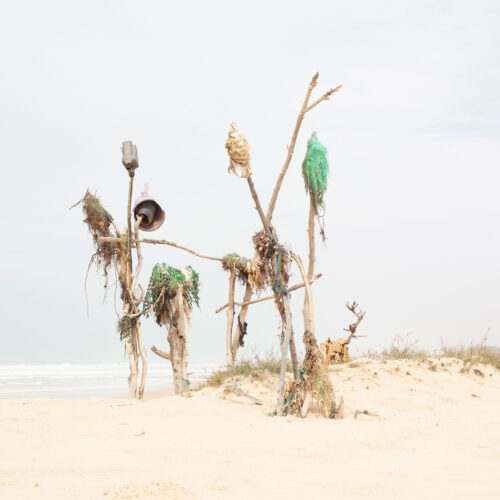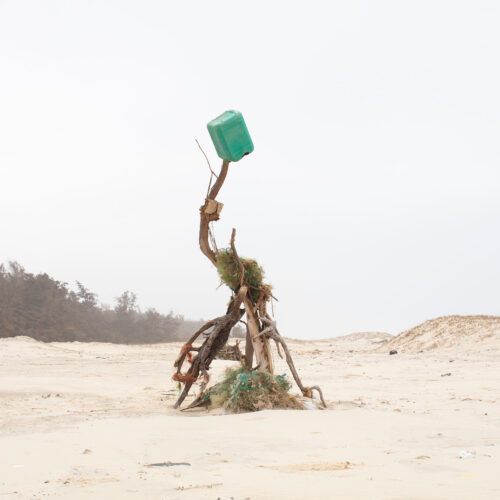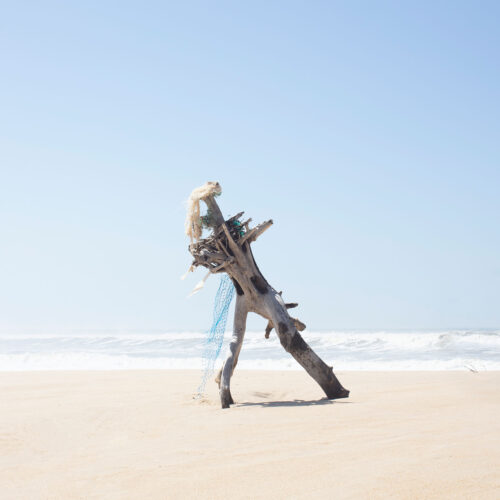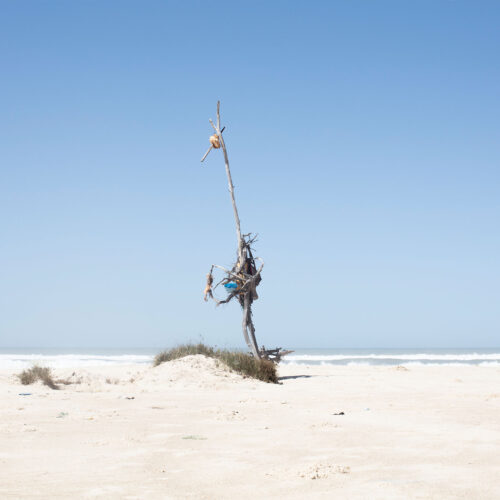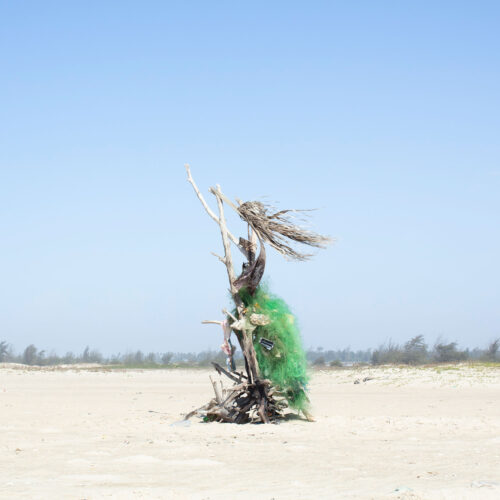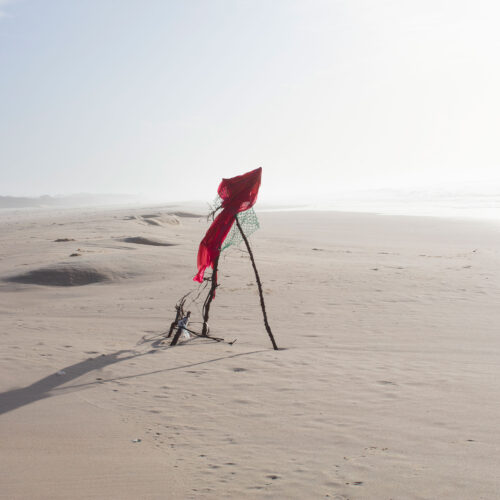KHAMEKAYE
El paisaje es una gran experiencia de la emoción vinculada a la mirada y a la conexión con el territorio. La contemplación nos relaciona con el entorno del que venimos, es decir, con nuestro origen y, por lo tanto, se convierte también en una experiencia ligada al espíritu. El propio término “paisaje” está asociado en origen a la acción y experiencia del ser humano. El paisaje es el resultado del trabajo humano sobre el territorio. Es el fruto de una acción cultural y, asimismo, creativa. La naturaleza, de la que constituye una revelación en el ámbito de las formas, es vivida, sentida y modificada por el hombre en el transcurso de la historia.
La serie Khamekaye está realizada en la Grande-Côte, una sección del litoral senegalés que abarca unos 150km, situado desde el norte de Dakar hasta la desembocadura del río Senegal. En esta gran superficie de playas y dunas se distinguen, de tanto en tanto, unas estructuras compuestas por ramas, plásticos, redes de pesca y diferentes objetos, elevándose en medio de esta gran extensión de mar, arena y vegetación. A primera vista parecen objetos informes, caóticos, como marañas de ramas y plásticos que parecen desechados por el mar. Sin embargo, su configuración, su enclave vertical en un lugar azotado por el viento, el agua, el salitre y cierto dinamismo en sus formas, hacen fijar aun más la mirada para descubrir qué son y qué hacen clavados en ese lugar concreto. El caos brinda descubrimientos maravillosos y poco a poco estas estructuras enmarañadas empiezan a adquirir, ante el espectador, formas más definidas: animales, criaturas fantásticas, seres concretos, con brazos, cuerpos, cabezas, en movimiento, en grupo, incluso en escorzo.
Los Khamekaye son señales, grandes hitos colocados a lo largo del litoral para marcar el lugar donde, hacia el interior, se encuentran los poblados. Tienen una intención muy concreta, una utilidad práctica y doméstica. Su posición no es arbitraria. Su presencia tampoco es caprichosa o inconsecuente. Desde el mar (a lo largo de esta extensión hay algunas zonas de gran actividad de pesca) y desde la arena, se puede conocer dónde se encuentra el poblado. Khamekaye significa hito en la lengua wolof, uno de los idiomas más hablados en Senegal y este término es empleado únicamente para designar estas señales de playa.
Pero el verdadero descubrimiento es ver que detrás de estas estructuras y de sus primitivos materiales encontrados, hay una voluntad estética y formal. La estructura deja de ser abstracta y se convierte en escultura, estableciendo una relación con el lugar (paisaje) y a la cultura (historia, sociedad, economía). La actividad creadora hay que analizarla en sus manifestaciones más elementales, en los actos que realizamos tan comúnmente que nos parecen habituales, cuando en realidad son, sin duda, extraordinarios. Nos encontramos con el principio creativo: el origen es la necesidad, el deseo, una utilidad concreta, básica (en este caso, señalizar). Pero la capacidad creadora es algo más que una habilidad del ser humano. Las posibilidades que inventamos pueden mantener o no el enlace con la realidad. En un caso serán posibilidades reales y en otro, posibilidades fantásticas.
La característica física clave del hito es la singularidad, un rasgo único o memorable en un contexto. La actividad que se asocia a un elemento puede también transformarlo en hito, así como los vínculos históricos u otros significados. Una vez que se adhiere una historia, un signo o un significado a un objeto, su valor como hito se constituye. Por lo tanto, son objetos que sirven para orientarse de forma muy general o de un modo simbólico y que abarcan todo el espectro de objetos disponibles. Mi fascinación por esta capacidad escultora con todo tipo de objetos encontrados, me llevó a crear mis propios hitos, señalando un lugar único. Correspondía a un punto concreto: mi lugar, mi poblado, mi territorio, en definitiva, mi paisaje. En la serie, unos y otros se mezclan como seres mitológicos. Se crea una relación entre ellos, una historia, aunque aparezcan aislados. Y estas estructuras aparentemente abstractas se convierten en criaturas reales que culminan en el centro de un paisaje de arena, con sus extrañas e irregulares formas. Se elevan como columnas llenas de significación y simbolismo pero, esencialmente, con una enorme belleza por sus proporciones, su relación inherente con el entorno y, sobre todo, por su misterio.
KHAMEKAYE
Landscape is a great emotional experience to do with seeing and connecting with the land. Contemplation forges a relationship with the environment that produced us, with our origins, and therefore also becomes an experience with a spiritual dimension. The very term “landscape” was originally associated with human action and experience. Landscape is the result of human work, human intervention on the land. It is the fruit of cultural and creative activity. Nature – of which landscapes are a formal manifestation – has been perceived, experienced and modified by human beings throughout history.
The Khamekaye series was executed in the Grande-Côte, a 150 km-long stretch of Senegal’s coastline between the northern outskirts of Dakar and the River Senegal estuary. Every now and then on this big expanse of beaches and sand dunes, one can make out structures made up of branches, plastic, fishing nets and various objects, rising up out of the sea, the sand and the vegetation. At first sight they look like formless, chaotic objects, tangles of branches and plastics that seem to have been washed up by the tides. But their composition, their vertical, somehow dynamic, presence in a place lashed by wind, water and salt invite curiosity as to what they are and what they are doing stuck out there in that particular place. Chaos provides opportunities to make wonderful discoveries, and little by little, to the observer’s eye, these tangled structures begin to take on more defined forms: animals, fantastic creatures, specific beings with arms, legs, heads, in movement, in groups, even foreshortened figures.
The Khamekaye are signs, great landmarks placed along the shore to mark places where there are villages further inland. They have a very specific purpose; a practical, domestic raison d’être. Their locations are not random, and their presence is not fanciful or unimportant. They make the locations of villages visible both from the sea (there are busy fishing zones all along this coast) and from the shore. Khamekaye is a word meaning “landmark” in Wolof, one of the most widely spoken languages in Senegal, and it is used exclusively to refer to these beach signals.
But the real discovery is the aesthetic, formal intent that lies behind these structures made of primitive found objects. The structures are no longer abstract: they have become sculptures, thus establishing a relationship with the place (the landscape) and with local culture (history, society, economy). Creative activity must be analysed in its most elementary manifestations, in the acts we perform so frequently that we consider them habits, even though they are really undoubtedly extraordinary. This is the creative principle: the origin is in necessity, desire, in a specific, basic purpose (in this case, to signal a village). But creative capacity is more than just a human talent. The possibilities we invent may or may not conserve a link with reality. Some possibilities will be real, others fantastic.
The key physical feature of the landmark is its uniqueness, something singular and memorable in a given context. The activity associated with an element, its historical ties and other connotations, may also turn it into a landmark. Indeed, an object’s value as a landmark is established precisely when it is endowed with a history, a symbolism or a meaning. Landmarks are therefore objects which serve as a very general or a symbolic means of orientation and which may encompass the whole spectrum of available objects. My fascination with the sculptural potential of different kinds of found objects led me to create my own landmarks, signalling this time a very specific location: my own place, my own village, my own territory – in short, my own landscape. In the series, these landmarks of my own become mixed up with those built by the locals. Together they all become like mythical beings, and although they appear isolated, a relationship is created between them, a history. These apparently abstract structures become real creatures, their peculiar, irregular forms constituting focal points in the sandy landscape. They stand like columns full of meaning and symbolism, but essentially they are immensely beautiful for their proportions, their inherent relationship with their surroundings and, above all, their mystery.

